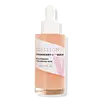What's inside
What's inside
 Key Ingredients
Key Ingredients

 Benefits
Benefits

 Concerns
Concerns

No concerns
 Ingredients Side-by-side
Ingredients Side-by-side

Water
Skin ConditioningGlycerin
HumectantPropanediol
SolventPentylene Glycol
Skin ConditioningPleiogynium Timoriense Fruit Extract
Skin ConditioningPodocarpus Elatus Fruit Extract
Skin ConditioningTerminalia Ferdinandiana Fruit Extract
AntioxidantSodium Acetylated Hyaluronate
HumectantSodium Hyaluronate
HumectantTremella Fuciformis Polysaccharide
Emulsion StabilisingAcacia Seyal Gum Extract
HumectantSr-Spider Polypeptide-1
Skin ProtectingPantothenic Acid
Skin ConditioningPhospholipids
Skin ConditioningSodium Hydroxide
BufferingSpirulina Platensis Extract
Skin ProtectingRaphanus Sativus Root Extract
AstringentCaprylyl Glycol
EmollientChlorphenesin
AntimicrobialTetrasodium Glutamate Diacetate
Polyglyceryl-6 Caprylate
EmulsifyingPolyglyceryl-4 Caprate
EmulsifyingPotassium Sorbate
PreservativePropylene Glycol
HumectantLeuconostoc/Radish Root Ferment Filtrate
Antimicrobial1,2-Hexanediol
Skin ConditioningCitric Acid
BufferingEthylhexylglycerin
Skin ConditioningHydroxyacetophenone
AntioxidantCarrageenan
Xanthan Gum
EmulsifyingSodium Glycolate
BufferingSodium Formate
BufferingPhenoxyethanol
PreservativeParfum
MaskingWater, Glycerin, Propanediol, Pentylene Glycol, Pleiogynium Timoriense Fruit Extract, Podocarpus Elatus Fruit Extract, Terminalia Ferdinandiana Fruit Extract, Sodium Acetylated Hyaluronate, Sodium Hyaluronate, Tremella Fuciformis Polysaccharide, Acacia Seyal Gum Extract, Sr-Spider Polypeptide-1, Pantothenic Acid, Phospholipids, Sodium Hydroxide, Spirulina Platensis Extract, Raphanus Sativus Root Extract, Caprylyl Glycol, Chlorphenesin, Tetrasodium Glutamate Diacetate, Polyglyceryl-6 Caprylate, Polyglyceryl-4 Caprate, Potassium Sorbate, Propylene Glycol, Leuconostoc/Radish Root Ferment Filtrate, 1,2-Hexanediol, Citric Acid, Ethylhexylglycerin, Hydroxyacetophenone, Carrageenan, Xanthan Gum, Sodium Glycolate, Sodium Formate, Phenoxyethanol, Parfum
Water
Skin ConditioningPropanediol
SolventGlycerin
HumectantLeuconostoc/Radish Root Ferment Lysate Filtrate
Skin ConditioningPanthenol
Skin ConditioningFragaria Ananassa Seed Extract
AntioxidantFragaria Vesca Fruit Extract
AstringentTerminalia Ferdinandiana Fruit Extract
AntioxidantSodium Hyaluronate
HumectantSea Water
HumectantCucumis Sativus Fruit Extract
EmollientPicea Abies Extract
Skin Conditioning3-O-Ethyl Ascorbic Acid
Skin ConditioningCarbomer
Emulsion StabilisingAminomethyl Propanol
BufferingBentonite
AbsorbentSodium Citrate
BufferingSodium Phytate
Citric Acid
BufferingCI 77491
Cosmetic ColorantCI 77499
Cosmetic ColorantWater, Propanediol, Glycerin, Leuconostoc/Radish Root Ferment Lysate Filtrate, Panthenol, Fragaria Ananassa Seed Extract, Fragaria Vesca Fruit Extract, Terminalia Ferdinandiana Fruit Extract, Sodium Hyaluronate, Sea Water, Cucumis Sativus Fruit Extract, Picea Abies Extract, 3-O-Ethyl Ascorbic Acid, Carbomer, Aminomethyl Propanol, Bentonite, Sodium Citrate, Sodium Phytate, Citric Acid, CI 77491, CI 77499
 Reviews
Reviews

Ingredients Explained
These ingredients are found in both products.
Ingredients higher up in an ingredient list are typically present in a larger amount.
Citric Acid is an alpha hydroxy acid (AHA) naturally found in citrus fruits like oranges, lemons, and limes.
Like other AHAs, citric acid can exfoliate skin by breaking down the bonds that hold dead skin cells together. This helps reveal smoother and brighter skin underneath.
However, this exfoliating effect only happens at high concentrations (20%) which can be hard to find in cosmetic products.
Due to this, citric acid is usually included in small amounts as a pH adjuster. This helps keep products slightly more acidic and compatible with skin's natural pH.
In skincare formulas, citric acid can:
While it can provide some skin benefits, research shows lactic acid and glycolic acid are generally more effective and less irritating exfoliants.
Most citric acid used in skincare today is made by fermenting sugars (usually from molasses). This synthetic version is identical to the natural citrus form but easier to stabilize and use in formulations.
Read more about some other popular AHA's here:
Learn more about Citric AcidGlycerin is already naturally found in your skin. It helps moisturize and protect your skin.
A study from 2016 found glycerin to be more effective as a humectant than AHAs and hyaluronic acid.
As a humectant, it helps the skin stay hydrated by pulling moisture to your skin. The low molecular weight of glycerin allows it to pull moisture into the deeper layers of your skin.
Hydrated skin improves your skin barrier; Your skin barrier helps protect against irritants and bacteria.
Glycerin has also been found to have antimicrobial and antiviral properties. Due to these properties, glycerin is often used in wound and burn treatments.
In cosmetics, glycerin is usually derived from plants such as soybean or palm. However, it can also be sourced from animals, such as tallow or animal fat.
This ingredient is organic, colorless, odorless, and non-toxic.
Glycerin is the name for this ingredient in American English. British English uses Glycerol/Glycerine.
Learn more about GlycerinPropanediol is an all-star ingredient. It softens, hydrates, and smooths the skin.
It’s often used to:
Propanediol is not likely to cause sensitivity and considered safe to use. It is derived from corn or petroleum with a clear color and no scent.
Learn more about PropanediolSodium Hyaluronate is hyaluronic acid's salt form. It is commonly derived from the sodium salt of hyaluronic acid.
Like hyaluronic acid, it is great at holding water and acts as a humectant. This makes it a great skin hydrating ingredient.
Sodium Hyaluronate is naturally occurring in our bodies and is mostly found in eye fluid and joints.
These are some other common types of Hyaluronic Acid:
Learn more about Sodium HyaluronateTerminalia Ferdinandiana Fruit Extract is from the Kakadu plum. The Kakadu plum is native to northern Australia. The Kakadu plum holds the record for having the highest amount of natural vitamin C.
This ingredient is an antioxidant. Antioxidants help fight free-radical molecules. Free-radical molecules are capable of damaging our cells and other genetic material. Antioxidants help stabilize free-radicals and thus may reduce the signs of aging.
The high vitamin C content of Kakadu plum also helps lighten skin. Vitamin C has been shown to block the process of skin darkening that leads to hyperpigmentation.
Kakadu plums have been used by indigenous cultures as medicine to help treat colds and as an antiseptic.
Learn more about Terminalia Ferdinandiana Fruit ExtractWater. It's the most common cosmetic ingredient of all. You'll usually see it at the top of ingredient lists, meaning that it makes up the largest part of the product.
So why is it so popular? Water most often acts as a solvent - this means that it helps dissolve other ingredients into the formulation.
You'll also recognize water as that liquid we all need to stay alive. If you see this, drink a glass of water. Stay hydrated!
Learn more about Water